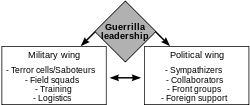Unconventional warfare: Difference between revisions
Extended confirmed users 38,079 edits obviously |
SOFREP1993 (talk | contribs) |
||
| (One intermediate revision by the same user not shown) | |||
| Line 14: | Line 14: | ||
[[Special Forces]], inserted deep behind enemy lines, are used unconventionally to train, equip, and advise locals who oppose their government. They can also spread subversion and propaganda, while they aid native resistance fighters, to ultimately cause a hostile government to capitulate. Tactics focus on destroying military targets while avoiding damage to civilian infrastructure and [[blockade|blockading]] military resupply are used to decrease the morale of government forces. |
[[Special Forces]], inserted deep behind enemy lines, are used unconventionally to train, equip, and advise locals who oppose their government. They can also spread subversion and propaganda, while they aid native resistance fighters, to ultimately cause a hostile government to capitulate. Tactics focus on destroying military targets while avoiding damage to civilian infrastructure and [[blockade|blockading]] military resupply are used to decrease the morale of government forces. |
||
In October of 2019 at a workshop which included [[David Kilcullen]] and [[Ben Connable]] at [[RAND]], Deputy Assistant Secretary of Defense [[Mick Mulroy]] publicly rolled out the Irregular Warfare Annex (IWA) to the [[National Defense Strategy]] of 2018. He explained that [[irregular warfare]] included [[counter-insurgency]], [[counter-terrorism]], [[unconventional warfare]], [[foreign internal defense]], [[sabotage]] and [[subversion]], as well as stabilization and information operations. It had traditionally been perceived as a predominately counterterrorism (CT) effort used to fight violent extremist organizations, but that under the IWA the skills will be applied to all areas of military competition. These included competition against global powers competitors like China and Russia as well as rogue states like North Korea and Iran. <ref>https://www.al-monitor.com/pulse/originals/2019/10/pentagon-irregular-tactics-counter-iran-military.html</ref> Mulroy said that the U.S. must be prepared to respond with "aggressive, dynamic, and unorthodox approaches to IW," to be competitive across these priorities. He also explained that under the IWA, both special operations and conventional forces would play a key role. <ref>https://www.rand.org/nsrd/news/2019/10/dasd-mulroy.html</ref><ref>https://www.al-monitor.com/pulse/originals/2019/10/pentagon-irregular-tactics-counter-iran-military.html</ref> |
|||
{{details|Unconventional warfare (United States Department of Defense doctrine)}} |
{{details|Unconventional warfare (United States Department of Defense doctrine)}} |
||
Revision as of 19:31, 24 October 2019
| Part of a series on |
| War |
|---|
 |
Unconventional warfare (UW) is the support of a foreign insurgency or resistance movement against its government or an occupying power. Whereas
Objectives
As with all forms of warfare, the general objective of unconventional warfare is to instill a belief that peace and security are not possible without compromise or concession. Two original definition are claiming: "The intent of U.S. Unconventional Warfare efforts is to exploit a hostile power’s political, military, economic, and psychological vulnerabilities by developing and sustaining resistance forces to accomplish U.S. strategic objectives." or according to John F. Kennedy: "There is another type of warfare—new in its intensity, ancient in its origin—war by guerrillas, subversives, insurgents, assassins; war by ambush instead of by combat, by infiltration instead of aggression, seeking victory by eroding and exhausting the enemy instead of engaging him. It preys on unrest."[2]
Unconventional warfare can be employed in furtherance of one of three strategic outcomes: Overthrow of an existing government or occupying power, disruption of the operations of that power, or the coercion of that power.[3]
Methods and organization
Unconventional warfare targets civilian population psychologically to
In October of 2019 at a workshop which included

The USA Department of Defense defines unconventional warfare as activities conducted to enable a resistance movement or insurgency to coerce, disrupt, or overthrow a government or occupying power by operating through or with an underground, auxiliary, and guerrilla force in a denied area. Also called UW.[7]
See also
- Asymmetric warfare
- Hybrid warfare
- Fourth generation warfare
- Irregular military
- Irregular warfare
- Low intensity conflict
- Partisan (military)
- Political warfare
- Psychological warfare
- Resistance movement
- Terrorism
- Unrestricted Warfare
- A seminal work on unconventional stay-behind warfare is Major Hans von Dach's Der Totale Widerstand (Total Resistance).
- Six-legged Soldiers - A scientific warfare book on another potential form of unconventional warfare, by Jeffrey A. Lockwood
US & NATO specific:
- Operation Gladio
- Project Eldest Son
- Reagan Doctrine
- Special Activities Division
- U.S. Army Special Forces
References
- ^ "Glossary". The Irregular Warrior. 2015-09-29. Retrieved 2017-09-07.
- ^ "U.S. Army Special Forces Unconventional Warfare Training Manual November 2010". U.S. ARMY. March 3, 2011.
- ^ "Unconventional Warfare Fundamentals". The Irregular Warrior. 2017-09-14. Retrieved 2017-09-17.
- ^ https://www.al-monitor.com/pulse/originals/2019/10/pentagon-irregular-tactics-counter-iran-military.html
- ^ https://www.rand.org/nsrd/news/2019/10/dasd-mulroy.html
- ^ https://www.al-monitor.com/pulse/originals/2019/10/pentagon-irregular-tactics-counter-iran-military.html
- ^ "Department of Defense Dictionary of Military and Associated Terms" (PDF). pp. JP 1-02. Retrieved 25 June 2019.
External links
- Insurgency Research Group – Multi-expert blog dedicated to the study of insurgency and the development of counter-insurgency policy.
- Allied war terminology (File #5a)
- goarmy.com/special_forces/unconventional_warfare
- [permanent dead link] Unconventional Warfare: Definitions from 1950 to the Present [dead link]
- Unconventional Warfare: A Better Path to Regime Change in the Twenty First Century
- Instruments of Statecraft: U.S. Guerrilla Warfare, Counterinsurgency, and Counterterrorism, 1940–1990
- Pentagon plans cyber-insect army
